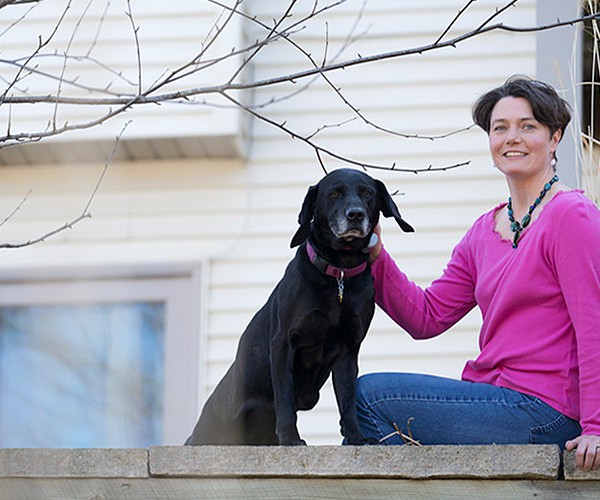Breadcrumb
Christine Petersen’s interest in zoonotic disease is catching on
By Keith Poehlman
Published on June 2, 2014
Christine Petersen, DVM, PhD, was just four years old when her grandmother predicted she would be a veterinarian. “She found me coaxing feral kittens out of the bushes at her hog farm,” Petersen says. “I figured [a veterinarian] was someone who worked with and helped animals, and that sounded good to me.”

But it wasn’t until Petersen was a veterinary student at Cornell University that she realized she could use her training to help not just animals, but to improve the well-being of humans, too.
Today, she’s an associate professor of epidemiology in the UI College of Public Health, where she conducts research on the prevalence and prevention of diseases that can be transmitted between animals and humans. Known as zoonotic diseases, these illnesses are spread directly between animals and humans, or indirectly through the work of mosquitoes or other vectors.
One Health
Petersen is part of a growing number of health and environmental science experts who believe that the health of humans is connected to the health of animals and the environment, a concept known as One Health.
According to Petersen, interest in One Health has been fueled by an increasing number of global outbreaks of relatively new infectious diseases.
The Centers for Disease Control and Prevention (CDC) notes that “approximately 75 percent of recently emerging infectious diseases affecting humans are diseases of animal origin.” Just some of these diseases include West Nile virus and the Severe Acute Respiratory Syndrome (SARS).
Petersen points to the 1999 West Nile virus outbreak as a milestone in the study of zoonotic diseases. That year the head pathologist at the Bronx Zoo in New York suspected that the dead birds at her facility had succumbed to the same virus that was causing severe inflammation of the brain—encephalitis—in people.
Evidence showed that humans were catching the virus from bites by mosquitoes that had also bitten infected birds. In spite of this, a CDC official disputed any possible link between humans and birds suffering from the virus.
Bringing Down Walls
That official’s statement was reflective of a wall that Petersen says has existed for decades between the fields of human medicine and veterinary medicine. But with each new emerging infectious disease outbreak, she has witnessed more and more professionals from these fields working together on zoonotic diseases rather than on their own.
“Biology does not divide us,” she says. “It brings us together. We have artificially divided ourselves into these fields. It’s myopic to look at them separately.”
Petersen’s microbiology professor at Cornell, Dr. Gordon Campbell, understood this long before the One Health field came into being.
“He taught Health with a big H,” she says, by stressing that animal health couldn’t be fully understood without factoring in the health of humans, plants, and the environment. He also encouraged his students to take part in exchange programs to observe veterinarians in developing countries.
Studying Transmission
While an exchange student in Kenya in 1999, Petersen saw firsthand the devastation that can be brought on by an infectious disease. At that time, fully one out of every ten Kenyans was infected with HIV.
Later, she did her dissertation at Harvard University on how the tropical parasite Trypanosoma cruzi causes heart muscle cells to stop working and has led to heart failure among people and dogs in Latin America, an illness known as Chagas’ disease. The parasite is transmitted to animals and people by so-called assassin bugs, also known as triatomine bugs or kissing bugs.
Petersen found that the rate of transmission of Chagas’ disease is particularly high among poorer South Americans because they often live in one-room houses that they share with pets and, unfortunately, assassin bugs.
Before joining the University of Iowa faculty in 2013, Petersen was an associate professor in the Department of Veterinary Pathology at Iowa State University, where she studied leishmaniasis. The disease causes painful sores and attacks the liver, spleen, and lymph nodes in both humans and dogs. It’s spread by sand flies that bite humans after biting infected dogs.
Her work on leishmaniasis led her to establish an ongoing collaboration with Mary Wilson, MD, a professor in the Department of Internal Medicine and Microbiology at the UI Carver College of Medicine, who has also done extensive research into the disease.
In 2012, Petersen gave a lecture on leishmaniasis in association with the One Health Commission, an organization made up of human, animal, plant, and ecosystem health professionals who collaborate to bring about better health for people, domestic animals, wildlife, plants, and the environment. During her talk, Petersen demonstrated the effect the environment can have on human and animal health by showing that as global temperatures have risen, so has the number of places sand flies now call home.
Helping Animal and Human Health
Petersen’s current research includes her ongoing study of leishmaniasis as well as examining animal vaccine safety and performing collaborative work to prevent infectious diseases in animal shelters.
Although Petersen’s love of animals led her to become a veterinarian, she ultimately feels that she can champion the cause of animal health by working within public health.
“As a veterinarian working directly in a public health field, I can specifically measure my impact in aiding both people and animals,” she says. “It’s part of the veterinary oath to protect public health. I take that oath to heart.”